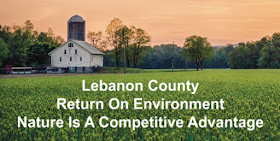A new Return On Environment study reports natural systems-- farmland, open space, forested areas and stream buffers-- contribute over $925 million annually to Lebanon County’s economy by filtering water, cleaning the air, controlling flooding and sustaining wildlife.
The study was published by Audubon Pennsylvania and the Kittatinny Ridge Coalition with the participation of the City of Lebanon Authority; Lebanon County Conservation District; Lebanon County Planning Department; Lebanon Valley Economic Development Corporation; Swatara Watershed Association; the Lebanon Valley Conservancy; and Visit Lebanon Valley.
The study was guided by a local steering committee of individuals from diverse backgrounds-- interested citizens and those with experience in nonprofits, government, and business-- who provided ideas, critical thinking, innovation, and data with across-the-board support.
The major objectives of the study were to--
-- The monetary value of natural system services (the flow of goods and services that benefits people, directly or indirectly, from ecosystem functions);
-- The value of improved air quality relating to healthcare costs;
-- The monetary value of outdoor recreation and the number of participants;
-- The spatial distribution of natural resources’ financial value; and
-- The integration of new land-use and habitat-expansion tools into everyday practice.
The report documented these major economic contributors to Lebanon County’s economy--
-- Agriculture: Agriculture in the county generates over $350 million in annual total sales from 1,149 farms averaging 94 acres each;
-- Recreation: Outdoor recreation in the county provides over $183.9 million in annual total revenue, creates 1,800 jobs and saves $67 million a year in healthcare costs;
-- Natural Systems: Open space, forested areas, watershed areas provide over $309.8 million in annual savings in producing clean drinking water, flood protection, recreation and tourism opportunities.
Challenges & Issues
Promoting sustainable economic growth while maintaining a high quality of life, low cost of living, good health, and a unique sense of place is Lebanon County’s major challenge.
A second, and more difficult, challenge is how to balance the health of natural systems to support a sustainable economy.
Research shows that the most efficient way to avoid excessive future costs is to increase the connectivity of large forests and riparian corridors (ecosystems of plant life growing near natural bodies of water) so that they may function and retain resiliency under a wider range of weather conditions
Also identified as major challenges and issues in the county, were--
-- Population Growth: Lebanon County has the second-fastest-growing population by county in the state;
-- Aging Population: An aging population is impacting the local population and culture. After high school, many young people look for jobs outside the region or go on to college and have difficulty finding jobs back home once they graduate.
-- Water Supply: Studies on possible water-supply shortages during drought times by 2030 have been conducted, which indicate that water supply may be an issue for future growth;
-- Water Quality: 58.6 percent of Lebanon County’s waterways are under some level of impairment. Less than half of the riparian buffers (vegetated areas along waterways that help shade and protect from the impact of adjacent land use) in the county are providing financial benefits;
-- Riparian Buffer Value: Current riparian buffers provide $47.7 million per year in return on environment;
-- Outdoor Recreation: As Millennials continue to prioritize outdoor recreation opportunities, participation rates should increase. However, the demand for outdoor recreation in Lebanon County exceeds the business capacity to meet it.
-- Farmland Loss: Since 2012, Lebanon County has lost 11.4 percent of its farmland and 5.74 percent of its farms.
-- Sprawl: Pennsylvanians have consumed more land per person than any other state. Sprawl accelerates the fragmentation and depletion of forests, wetlands, and other open areas where cost-free natural system services occur, and contributes to the loss of critical habitat. Commercial and industrial development, farms, and open land generate more revenue than they require in services.
Click Here for the summary report. Click Here for a brochure on the study. Click Here to watch a short video on the report.
John Rogers, Keystone Conservation Trust, Tom West, Greener Planning and Ben Goodman Creative supported the study with consulting services. The Swatara Watershed Association for supporting the study and Jo Ellen Litz for providing facilities for the Lebanon County Return on Environment meetings.
The Lebanon County ROE report is one of a series of studies documenting the value of natural systems in Berks, Carbon, Cumberland, Dauphin, Lehigh and Perry counties supported by the Kittatinny Ridge Coalition.
For more information, visit the Kittatinny Ridge Coalition Return On Environment webpage.
Related Articles - Return On Environment:
PA Township News: The Economic Value Of Green Infrastructure: Calculating A Return On Investments In Parks, Watershed Restoration, Farmland BMPs, Open Spaces
[Posted: March 31, 2020] PA Environment Digest


No comments:
Post a Comment